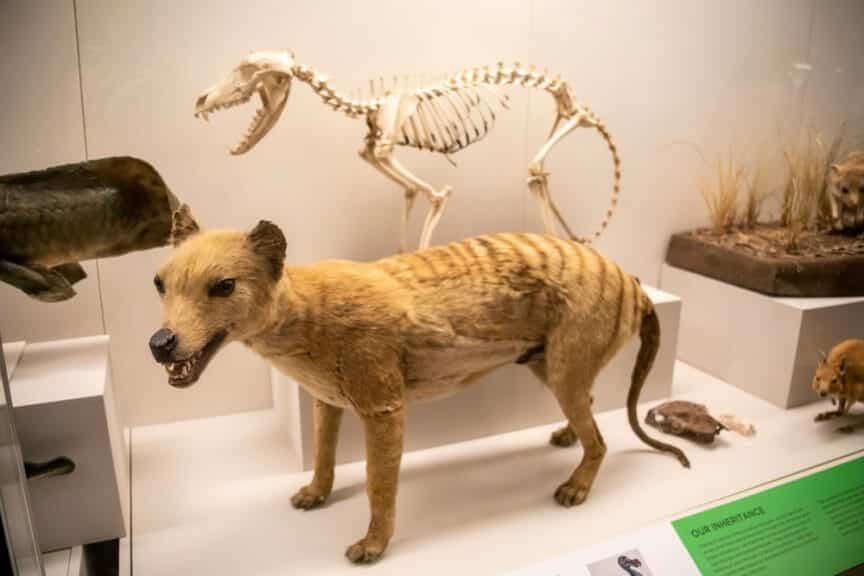In a jaw-dropping scientific twist, geneticists have pulled off a feat that’ll make your head spin: they’ve cracked the genetic code of the Tasmanian tiger, a creature that vanished from most of its stomping grounds some two millennia ago. This striped, dog-sized carnivore, scientifically known as Thylacinus cynocephalus, was a Tasmanian and Australian native, but it met its tragic end when the Europeans rolled into town.
The thylacine, folks, faced a harsh demise, accused of sheep-slaughter by the early European settlers. The price on its head was a crisp pound, and in 1888, a bounty of that caliber was slapped on every adult thylacine out there. The heartbreaker, though, came in the 20th century when the last known member of this species breathed its last in 1936, locked up in captivity at the Beaumaris Zoo in Hobart, Tasmania.
But hold on to your lab coats, because the story doesn’t end there. No siree! Scientists are like bloodhounds on the trail, and they’ve uncovered a jackpot of knowledge about this top-tier apex predator. A genetic goldmine, if you will. They’ve managed to shed light on the gene mechanics of this long-dead beast, and it’s a game-changer in the world of biology. Plus, it might just give us a fighting chance at resurrecting the Tasmanian tiger.
“This is the first time that we have had a glimpse into the existence of thylacine-specific regulatory genes, such as microRNAs, that got extinct more than one century ago,” said Marc R. Friedländer, the hombre from the Department of Molecular Biosciences at Stockholm University.
Now, here’s the kicker: these brave researchers over at Stockholm University went and snagged some RNA (Ribonucleic acid) molecules from a Tasmanian tiger specimen that had been chillin’ at room temperature in the Swedish Museum of Natural History for a whopping 130 years. They wrangled RNA from muscle and skin tissues, decoding genes that were straight-up thylacine-specific. The official word? They pulled off “the reconstruction of skin and skeletal muscle transcriptomes from an extinct species for the first time.”
Transcriptomes, by the way, are the whole shebang of RNA molecules dancing their dance within a cell or tissue. Studying these critters helps us understand how genes do their thing in individual cells, spot changes in gene behavior in sick and healthy cells, and get the lowdown on what’s cooking in an animal’s cellular kitchen.
But here’s the kicker, friends: RNA from way-back-when is like trying to find a needle in a haystack during a thunderstorm. DNA? Yeah, that stuff sticks around. They’ve yanked it out of animals that kicked the bucket a million years ago. RNA? Not so much. But these scientists weren’t gonna be stopped by a pesky obstacle like that.
And speaking of hurdles, there’s this whole shebang about bringing the Tasmanian tiger back to life, a gig that’s giving even the smartest scientists some serious brain strain. De-extinction? It’s like herding cats in a tornado, folks. A real doozy.
Colossal Biosciences is wearin’ the sheriff’s badge in the de-extinction showdown, aiming to craft a stand-in for the thylacine. But let me tell ya, it’s like tryin’ to build a rocket ship out of toothpicks. It’s a puzzle with pieces that don’t quite fit.
“Resurrecting the Tasmanian tiger or the woolly mammoth is not a trivial task and will require a deep knowledge of both the genome and transcriptome regulation of such renowned species, something that only now is starting to be revealed,” said Emilio Mármol, the head honcho behind this study.
The mission here wasn’t just to play Dr. Frankenstein with the Tasmanian tiger; it was about unraveling the secrets of this top-tier predator’s genes. But don’t you fret, ’cause this big discovery is like a roadmap to recovering RNA from critters long gone. These scientists? They’ve got their sights set on other ancient animals like the woolly mammoth. And who knows what else they might dig up – maybe even some RNA from old viral genomes like SARS-CoV2. It’s like a treasure hunt in the annals of history, folks, and they’re just getting started. Yeehaw!






